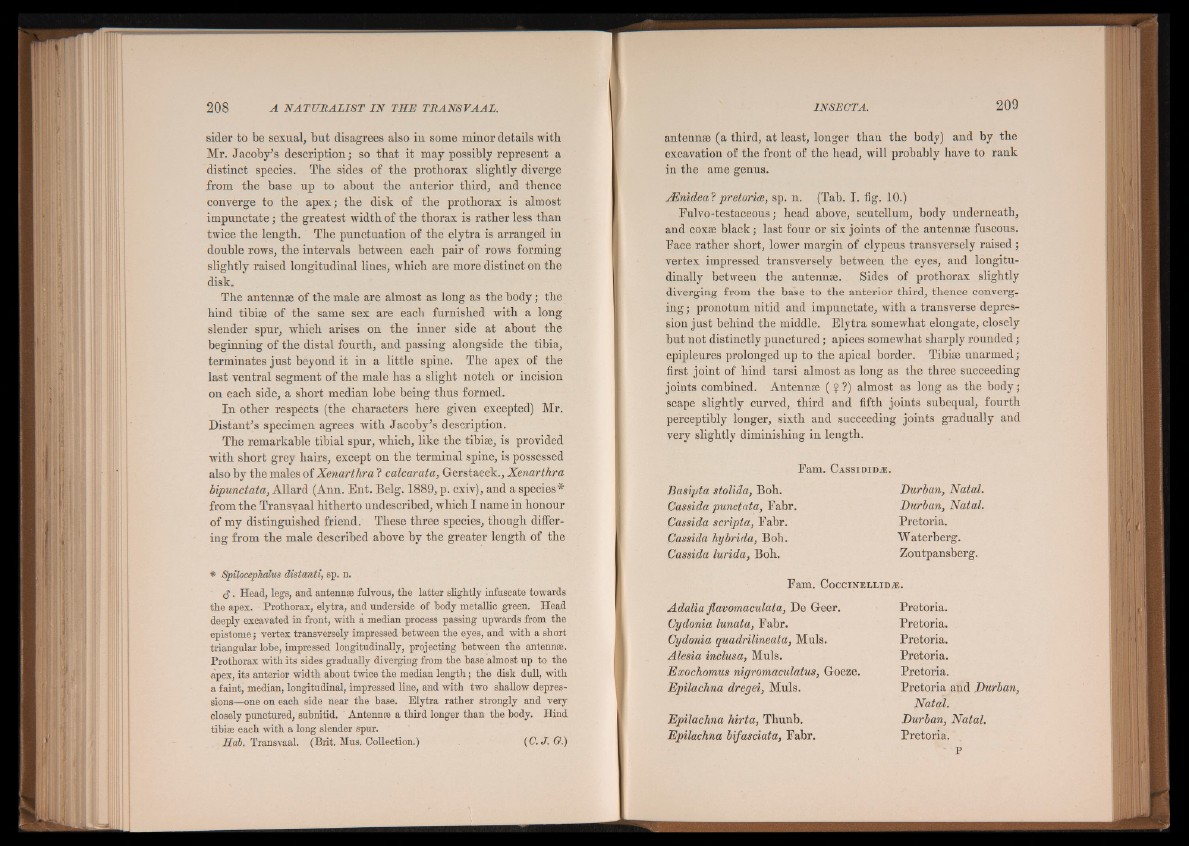
sider to be sexual, but disagrees also iu some minor details with.
Mr. Jacoby’s description; so tbat it may possibly represent a
distinct species. The sides of the protborax slightly diverge
from the base up to about the anterior third, and thence
converge to the apex; the disk of the prothorax is almost
impunctate; the greatest width of the thorax is rather less than
twice the length. The punctuation of the elytra is arranged in
double rows, the intervals between each pair of rows forming
slightly raised longitudinal lines, which are more distinct on the
disk.
The antennae of the male are almost as long as the body; the
hind tibiae of the same sex are each furnished with a long
slender spur, which arises on the inner side at about the
beginning of the distal fourth, and passing alongside the tibia,
terminates just beyond it in a little spine. The apex of the
last ventral segment of the male has a slight notch or incision
on each side, a short median lobe being thus formed.
In other respects (the characters here given excepted) Mr.
Distant’s specimen agrees with Jacoby’s description.
The remarkable tibial spur, which, like the tibiae, is provided
with short grey hairs, except on the terminal spine, is possessed
also by the males of Xenarthra ? calcarata, Gerstaeck., Xenarthra
bipunctata, Allard (Ann. Ent. Belg. 1889, p. cxiv), and a species*
from the Transyaal hitherto undescribed, which I name in honour
of my distinguished friend. These three species, though differing
from the male described above by the greater length of the
* Spilocephdlus distanti, sp. n.
cJ. Head, legs, and antennae fulvous, the latter slightly infúscate towards
the apex. Prothorax, elytra, and underside of body metallic green. Head
deeply excavated in front, with a median process passing upwards from the
epistome; vertex transversely impressed between the eyes, and with a short
triangular lobe, impressed longitudinally, projecting between the antennae.
Prothorax with its sides gradually diverging from the base almost up to the
apex, its anterior width about twice the median length; the disk dull, with
a faint, median, longitudinal, impressed line, and with two shallow depressions—
one on each side near the base. Elytra rather strongly and very
closely punctured, subnitid. Antennae a third longer than the body. Hind
tibiae each with a long slender spur.
Hab. Transvaal. (Brit. Mus, Collection.) (C. J. O.)
antennae (a third, at least, longer than the body) and by the
excavation of the front of the head, will probably have to rank
in the ame genus.
AZnidea? pretorice, sp. n. (Tab. I. fig. 10.)
Fulvo-testaceous; head above, scutellum, body underneath,
and coxae black; last four or six joints of the antennae fuscous.
Face rather short, lower margin of clypeus transversely raised ;
vertex impressed transversely between the eyes, and longitudinally
between the antennae. Sides of prothorax slightly
diverging from the base to the anterior third, thence converging
; pronotum nitid and impunctate, with a transverse depression
j ust behind the middle. Elytra somewhat elongate, closely
but not distinctly punctured; apices somewhat sharply rounded;
epipleures prolonged up to the apical border. Tibiae unarmed;
first joint of hind tarsi almost as long as the three succeeding
joints combined. Antennae ( ? ?) almost as long as the body;
scape slightly curved, third and fifth joints subequal, fourth
perceptibly longer, sixth and succeeding joints gradually and
very slightly diminishing in length.
Fam. C a s s i d id ìe.
Basipta stolida, Boh.
Cassida punctata, Fabr.
Cassida scripta, Fabr.
Cassida hybrida, Bob.
Cassida lurida, Boh.
Durban, Natal.
Durban, Natal.
Pretoria.
Waterberg.
Zoutpansberg.
Fam. C o c c in e l l id jE.
Adalia flavomaculata, De Geer.
Cydonia lunata, Fabr.
Cydonia quadrilineata, Muls.
Alesia inclusa, Muls.
Eacochomus nigromaculatus, Goeze.
Epilachna dregei, Muls.
Epilachna hirta, Thunb.
Epilachna bifasciata, Fabr.
Pretoria.
Pretoria.
Pretoria.
Pretoria.
Pretoria.
Pretoria and Durban,
Natal.
Durban, Natal.
Pretoria.
! p